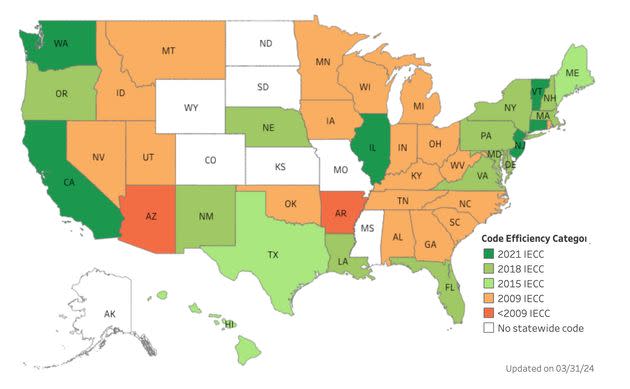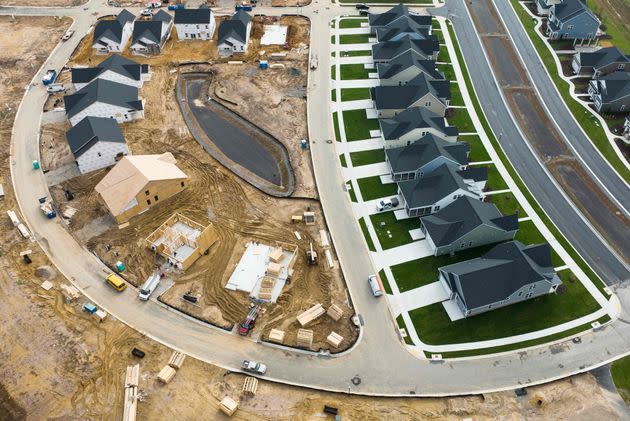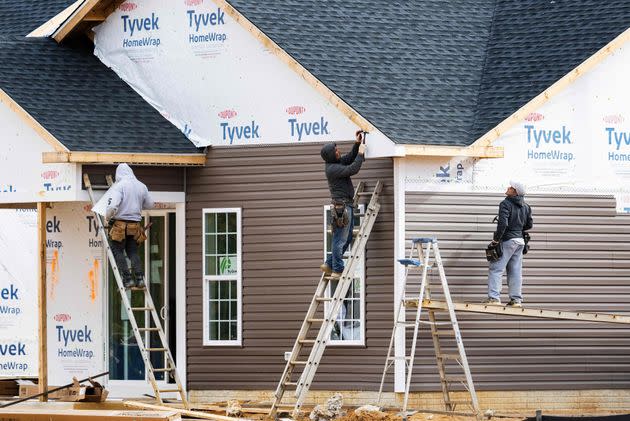Biden Is Stalling On A Rule That Would Save Americans Nearly $1.5 Billion
- Oops!Something went wrong.Please try again later.
- Oops!Something went wrong.Please try again later.
The Biden administration is racing to finalize regulations to curb planet-heating emissions from lightbulbs, automobiles and trucks before a key deadline, after which any new rules could be undone by Donald Trump if he retakes the White House.
With just over six months before the election, at least one major Biden proposal appears to be stalled: an update to the federal housing rules that agency experts estimate would save homeowners nearly three times more money on energy bills than it would add to construction costs, spread out over a 30-year mortgage.
Changing those housing rules would impact about 160,000 new houses and condos built each year in some of the nation’s fastest-growing — and most expensive — housing markets. The Biden administration is now looking to the rules as a model for reforming other federal housing programs, which would supercharge the White House’s efforts to curb both emissions and rising utility bills.
But the final rule is inching through the bureaucratic process at an unusually slow rate, taking weeks or months to advance to technical next steps that regulations can typically reach in a matter of days. It’s unclear what’s causing the delay. And due to a legal quirk, if President Joe Biden loses reelection, Trump could have final say over any rule enacted after May or June.
Critics of the greener housing rules say the changes would raise the price of new homes when half of Americans already say they can’t find affordable housing, home ownership rates are stagnating and the bulk of inflation stems from the climbing cost of shelter. Republicans tried to block the rule from taking effect last year.
Requiring new homes to meet stricter energy efficiency standards to qualify for federally-insured loans would add a combined $560 million in building costs, based on a single-year average of construction prices between 2019 and 2021, the Department of Housing and Urban Development found in its preliminary determination last year.
But over the same period a buyer would pay off a house, the thicker insulation and modern windows mandated under the latest model building codes would save the country as much $1.5 billion in energy costs. Some markets could see new homes that save 24% more energy than models built to the previous year’s standards. The 90-page “national blueprint” for decarbonizing the building sector the Energy Department published this month calls HUD and other federal lending agencies to swiftly adopt the latest codes.
A spokesperson for HUD declined to comment on what’s causing the delay.
“HUD is in the process of finalizing the determination, recognizing the interest in doing so as promptly as possible,” the spokesperson told HuffPost in an emailed statement Friday.
The U.S. has no official nationwide building code. Instead, states can choose to adopt model standards written and regularly updated by private code-writing organizations such as the International Code Council, a nonprofit that convenes local governments, utilities and construction industry professionals. Compared to previous rounds of codes, the ICC’s 2021 homebuilding guidelines delivered double-digit improvements on the energy efficiency of new homes.

Yet few states have voluntarily taken up those new, greener benchmarks.
Nearly half the country — most of the Southeast, Midwest and Mountain West — uses the ICC’s energy standards from at least 15 years ago. Eight states — Alaska, Colorado, Kansas, Mississippi, Missouri, North Dakota, South Dakota and Wyoming — have no statewide building codes at all, instead allowing counties and towns to decide for themselves how to impose standards on builderss. Just six states – California, Connecticut, Illinois, New Jersey, Vermont, and Washington – have adopted the standards in line with the latest ICC housing codes, according to Energy Department data updated a week ago.
That number could soon grow. Congress granted Biden $1 billion to give out to states to help them adopt newer and stricter codes. And the U.S.′ Balkanized housing code system is one reason why stricter federal standards for housing loans are critical for cutting back on emissions. Even though the U.S. can’t force states or cities to adopt the latest ICC code, home loans give the federal government another lever to nudge states toward cleaner buildings.
“This has been long overdue,” said Lowell Ungar, the director of federal policy at the watchdog American Council for an Energy-Efficient Economy. “Each month of delay means thousands more homes with poor insulation, leaving residents with high energy bills for decades. Getting this done will lower families’ overall housing costs.”
The National Association of Home Builders, the largest trade group representing construction companies and real estate developers, told HuffPost that “mandating” the use of the 2021 building codes “is certainly not the answer.”
“This move will significantly limit access to federally-backed financing options for many first-time home buyers, rural home buyers, other home buyers with limited financial resources, and also developers of affordable apartments,” the NAHB warned. “In short, this blatant federal overreach is a counterproductive, short-sighted strategy that will exacerbate the nation’s housing affordability crisis and hurt the nation’s most vulnerable house hunters and renters.”
The American Gas Association, which successfully struck key climate provisions from the energy codes due out in 2024, said federal housing regulators should reject the 2021 codes. In an emailed statement, the gas-utility lobby criticized an Energy Department analysis showing that the most recent codes cut back on wasted energy, citing an industry study.
“HUD and USDA should not accept the revised code or standard provisions that negatively affect the availability or affordability of new construction of single and multifamily housing,” the AGA told HuffPost.
Federal law requires regulatory agencies to routinely ramp up the criteria for housing loans as more efficient codes come out. Yet the only time the codes for federal housing were updated was in 2015, when the Obama administration required that new homes meet the ICC’s 2009 codes. The Trump administration briefly gutted the guidelines for adopting new codes, a move Biden promptly reversed.
By the time Biden took office, building codes had quietly become a new battleground in the fight to transition to cleaner energy.
One benefit of greener homes is that they leave homeowners less vulnerable to energy price swings from war or extreme weather disrupting supplies.
“The most predictable and common cause of people leaving their homes is the energy burden and cost that can go up in such an unpredictable manner based on geopolitics or weather,” said Amy Boyce, senior director of buildings and energy at the Institute for Market Transformation, a think tank focused on decarbonizing buildings.
Utility debt swelled to a record of over $20 billion last year as ratepayers struggled to catch up on electricity and heating bills in arrears. One survey found nearly one-third of Americans in October said they had cut back on or skipped necessary expenses in the past year to cover energy bills. Now states across the country are allowing utilities to jack up rates to help pay for modernizing the grid.
“It’s so dangerous to say, ‘OK, we’re worried about this one aspect of cost, but we’re just going to leave that much more unpredictable aspect for people to figure out later on their own,’” Boyce said.
In the wake of the United Nations’ dire 2018 climate science report, cities and towns across the U.S. enacted laws mandating emissions cuts. But they could only do so much: Local governments have little control over the power plants and automobiles that produce the bulk of carbon pollution. They do, however, control what kinds of houses, offices and storefronts go up.
The ICC, which was formed in the 1990s as the U.S. sought to consolidate disparate code-writing organizations, provided an opportunity for local leaders to influence how houses are built in the whole country. While industry representatives could weigh in on updates to the ICC’s codebook, only officials from elected governments could vote on the final product.

For years, the ICC codes became only barely more energy-efficient with each update. But the ICC codes governments voted to enact in 2021 saw gains of as much as 14%.
Environmentalists, architects and green builders hailed the new codes. Industry groups balked. Trade associations representing gas utilities lobbied the ICC to strip key climate-friendly provisions, like rules that would require new homes to include the circuitry for electric appliances, car chargers and solar panels.
After the backlash, the ICC eliminated governments’ right to vote on codes altogether, moving instead to a “consensus” committee system that granted builders and fossil fuel companies more influence over the process. The Biden administration warned that those changes harmed the ICC code-writing process’s democratic legitimacy.
Promising to enshrine the wins of the latest code, Kevin Bush, HUD’s deputy assistant secretary for grant programs, told advocates in a July 2021 letter that the agency expected to take the first major step toward enshrining the newest codes into regulations “later this year.”
HUD did not submit its draft to the White House’s Office of Management and Budget until August 2022. It took OMB eight months to complete its review of the determination — a process that appeared to have ended only hours after HuffPost contacted the agency about the stalled regulation in March 2023.
The proposal to update the housing loan standards then went to the White House’s Office of Information and Regulatory Affairs. The OIRA completed its review and sent the regulation back to HUD last month.
At other agencies, such as the Energy Department, finalized regulations typically appear on the Federal Register — the crucial last step before a regulation goes into force — within days of returning to the regulators from OIRA review.
After nearly four weeks, HUD has yet to publish its final rule on the Federal Register.

There’s no obvious reason for the rule to be stalled. While the final draft is not out, the language on the OIRA’s website indicated that the agency returned the proposal to HUD without any major changes. Some advocates privately speculated that HUD could be facing internal upheaval since HUD Secretary Marcia Fudge stepped down and retired last month, leaving her temporary replacement in charge.
Unlike mortgages backed by HUD or the Agriculture Department, loans issued under the Federal Housing Finance Agency don’t require homes to follow any specific energy codes, nor do the mortgages purchased by the federally related Fannie Mae and Freddie Mac lenders. An activist campaign launched in November is calling for those agencies to implement similar standards to those HUD uses. The administration told E&E News it would consider the move in December.
“If HUD doesn’t move forward, that [effort] faces an almost insurmountable hurdle,” Boyce said.
The clock is ticking. Under a little-known statute called the Congressional Review Act, lawmakers can undo federal rules up to 60 days after they’re put in place. House Republicans have already repeatedly held votes against the Biden administration’s proposed regulations. But these have so far amounted to nothing but symbolism, since Democrats still control the Senate, and Biden would almost certainly veto any legislation passed in protest of his climate agenda.
Still, since the 60 working days covered by the law aren’t necessarily consecutive, the period always stretches out over more than two months and could eclipse the end of Biden’s first term in office. If Trump wins the presidency and Republicans win the Senate and keep the House, Biden-era climate rules would likely be rolled back.
Legal experts disagree on when the CRA deadline will actually land. Based on the House of Representatives’ calendar, the law firm Hunton Andrews Kurth estimated it will be on May 22, while based on the Senate calendar, the deadline would be June 7, according to the law firm Venable.
The ICC is due out with its 2024 codes in the next few weeks. It had looked poised to put out landmark climate provisions designed to make going electric easier and cheaper for homeowners. Up to 90% of experts involved in writing the code supported the green measures. But gas companies once again appealed. At the last minute, the ICC’s board intervened last month, and granted all the fossil fuel firms’ requests.
Related...
Biden Is Mysteriously Defying A Law That Could Spur 20,000 New Green Homes Per Month
Biden Moves To Mandate Greener Building Codes In One-Sixth Of New Houses
The ‘Scandal’ That Might Completely Upend A System America Has Relied On For Decades
Gas Industry Guts Building Codes Meant To Make Going Electric Cheaper
